History
Those Who Left Marks on the Princes' Islands
- Details
- Created on 19 February 2013
- Last Updated on 01 April 2013
Eirene; Byzantium's First and Only Empress Was Exiled to Büyükada
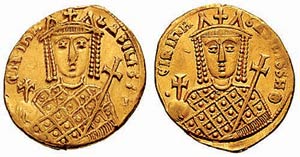 The empress Irene was the first and only female sovereign of Byzantium but she had been dethroned and arrested following a palace coup. Then, 1209 years ago, escorted by armed guards, she was taken to the convent on Büyükada.?Irene was locked away in a cell. As she?gazed from the window facing Sedefadası (Terebinthos), she felt the irony ofher situation. She was the one who had commissioned theconstruction of this convent, but now she was imprisoned in it. Sometime later, she was secretly exiled to Midilli Island (Lesbos).Irene did not survive for long.
The empress Irene was the first and only female sovereign of Byzantium but she had been dethroned and arrested following a palace coup. Then, 1209 years ago, escorted by armed guards, she was taken to the convent on Büyükada.?Irene was locked away in a cell. As she?gazed from the window facing Sedefadası (Terebinthos), she felt the irony ofher situation. She was the one who had commissioned theconstruction of this convent, but now she was imprisoned in it. Sometime later, she was secretly exiled to Midilli Island (Lesbos).Irene did not survive for long.
Her last wish was, “Lay my body to rest in the Saint Nicholas Chapel to the left of the Virgin Mary Church at the monastery I built with my sorrowful and suffering heart on Prinkipo Island (Büyükada) in the sight of God.” And that is what they did.
M. Kemal Atatürk
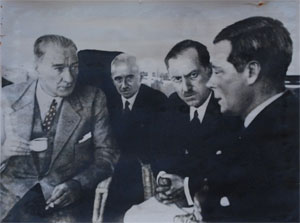 Atatürk visited Büyükada’yı ve Anadolu Club frequently. He met important state persons. Notable guests have included Atatürk and Ismet Inönü as well as foreign heads of state: Elefterios Venizelos, Prime Minister of Greece (1924); King Amanullah Han of Afghanistan (1930); King Carol of Romania and Madame Lupescu (1933); General Metaxas, the Greek dictator (1936); Shah Riza Pahlavi of Iran (1964); and Nikolau Ceausescu, the Romanian dictator (1976). When Atatürk visited the club he stayed in Room 25, which is preserved as it was in his time. In the garden of the club there is a monument to Atatürk, dedicated in 1981 to mark the centenary of his birth. The club cannot be visited, but one can observe the beautiful buildings and grounds from the gateway.
Atatürk visited Büyükada’yı ve Anadolu Club frequently. He met important state persons. Notable guests have included Atatürk and Ismet Inönü as well as foreign heads of state: Elefterios Venizelos, Prime Minister of Greece (1924); King Amanullah Han of Afghanistan (1930); King Carol of Romania and Madame Lupescu (1933); General Metaxas, the Greek dictator (1936); Shah Riza Pahlavi of Iran (1964); and Nikolau Ceausescu, the Romanian dictator (1976). When Atatürk visited the club he stayed in Room 25, which is preserved as it was in his time. In the garden of the club there is a monument to Atatürk, dedicated in 1981 to mark the centenary of his birth. The club cannot be visited, but one can observe the beautiful buildings and grounds from the gateway.
Fethi Okyar
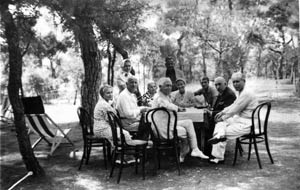 Ali Fethi Okyar had been a close friend of Mustafa Kemal Atatürk since their childhood. Fethi Okyar- soldier, diplomat, MP and minister- became the leader of the opposition the Free Republic Party, established in 1930 with Atatürk’s approval and support. But in the same year, finding it impossible to continue the party, he retreated to his house on Büyükada.
Ali Fethi Okyar had been a close friend of Mustafa Kemal Atatürk since their childhood. Fethi Okyar- soldier, diplomat, MP and minister- became the leader of the opposition the Free Republic Party, established in 1930 with Atatürk’s approval and support. But in the same year, finding it impossible to continue the party, he retreated to his house on Büyükada.
İsmet İnönü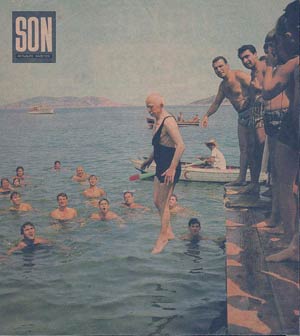
Ismet Inonu, first Turkish Prime Minister and later President of the Turkish Republic. Ismet Inönu, first rented the house originally known as the Mavromatakis Köşku on Heybeliada, as a summer home in 1924, when he recuperated there after an illness. The Inönus bought the house in 1934 for 9,500 liras, with new furniture presented to them as a gift by Atatürk. Eventually the family decided to have the house preserved as a museum under the Inönu Foundation, restored just as it was when Ismet Paşa moved there in 1937.
Yesari Asım Arsoy
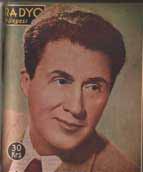 "Biz Heybeli’de her gece mehtaba çıkardık" In a little park next to the Naval High School there is a statue of Yesari Asim Arsoy (1896-1992), famous as the composer of a song celebrating Heybeli
"Biz Heybeli’de her gece mehtaba çıkardık" In a little park next to the Naval High School there is a statue of Yesari Asim Arsoy (1896-1992), famous as the composer of a song celebrating Heybeli
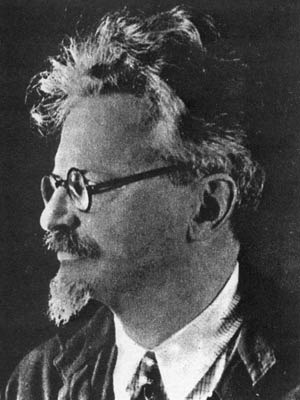
Lev Trotsky
Lev Davidovich Trotsky, one of the leaders of the Soviet Revolution, came to Istanbul when forced into exile by Stalin in 1929 and spent most of his four-year stay in Istanbul on Büyükada.
Trotsky left Büyükada on 17 July 1933, never to return. Despite his isolation on the island he seems to have enjoyed his exile there, as evidenced by the last entry he made in his notebook on the day he departed: "It has been four and one-half years. I have the strange feeling of having my feet firmly planted on Büyükada."
Label on the Famous Kulüp Rakısı

 Ihap Hulusi Görey, a graphic designer and painter, and Fazıl Ahmet Aykaç, a poet, author, teacher and MP, both from Kınalıada, were close friends. They got together from time to time on their island and sometimes at the Büyükada Anatolian Club.
Ihap Hulusi Görey, a graphic designer and painter, and Fazıl Ahmet Aykaç, a poet, author, teacher and MP, both from Kınalıada, were close friends. They got together from time to time on their island and sometimes at the Büyükada Anatolian Club.
His label for the famous Kulüp Rakısı--the label still used today--shows two very stylish, handsome gentlemen drinking raki. They are said to be Fazıl Ahmet Aykaç and Ihap Hulusi himself, pictured drinking at the Anatolian Club. With this label, designed in 1932, the famous artist immortalised their friendship.
Lefter Küçükandonyadis
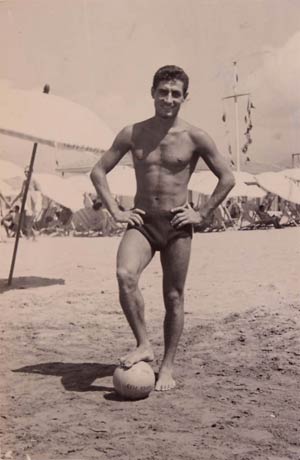 Lefter Küçükandonyadis played first for Taksimspor. After his military service, at age 21, he signed with Fenerbahçe, where he scored 407 goals in 605 games. He was the first footballer to wear the national jersey 50 times, scoring 22 goals in international games. Lefter, still a football legend, is now 86 years old and lives on Büyükada.
Lefter Küçükandonyadis played first for Taksimspor. After his military service, at age 21, he signed with Fenerbahçe, where he scored 407 goals in 605 games. He was the first footballer to wear the national jersey 50 times, scoring 22 goals in international games. Lefter, still a football legend, is now 86 years old and lives on Büyükada.
Mina Urgan
“Trotsky used to live in a residence on Nizam Street at Büyükada, with a garden?that stretched all the way to the shore. He never walked about in the streets, but went fishing on his boat almost every day. One day, when I was swimming offshore I recognized Trotsky’s boat. We were be able to identify this boat from afar, because there were two Russian bodyguards on the bow and stern.?In the middle sat the Greek fisherman?that pulled the oars and Trotsky holding?his fishhook. I quickly swam towards the?boat and held onto the side and practically came face to face with Trotsky. One of the bodyguards said ‘Go, go.’ (Actually he said ‘Go, go’ with a Russian accent.) I wanted to use my fatigue as an excuse to hold on so I could watch Trotsky a bit longer.”
Mina Urgan,
The Memories of a Dinosaur
Ziya Gökalp
Yahya Kemal persuaded his friend, Ziya Gökalp (1876-1924), to move to Büyükada. After Gökalp came, Turkish nationalist intellectuals such as Ahmet Ağaoğlu, Hamdullah Suphi, Celal Sahir, Necmettin Sadık and Fuat Köprülü began to gather on Büyükada.?Gökalp’s illness worsened in 1924 he was taken to Büyükada from Nişantaşı. While he was ill on the island, he edited his book, Türk Medeniyet Tarihi.
He resided at: Fatma Hurrem House, Albayrak Sokağı (Maden) No:17?. Rotenberg Mansion, Çankaya Caddesi Albayrak Sokak (Maden) No: 6
Melih Cevdet Anday
 Melih Cevdet Anday, one of the most important poets in Turkish literature, penned the often-quoted line about the island, “Ada vapuru yandan çarklı...”. Anday was one of the founders of the Garip movement of poetry and the philosophical poetic movement. UNESCO considered him to be a writer as important as Cervantes, Dante and Tolstoy. He wrote articles and essays in newspapers under both his real name and penname and also did translations. His poems, essays, criticisms, plays and novels received many awards. He spent the last years of his life on Büyükada and he is buried on the island.
Melih Cevdet Anday, one of the most important poets in Turkish literature, penned the often-quoted line about the island, “Ada vapuru yandan çarklı...”. Anday was one of the founders of the Garip movement of poetry and the philosophical poetic movement. UNESCO considered him to be a writer as important as Cervantes, Dante and Tolstoy. He wrote articles and essays in newspapers under both his real name and penname and also did translations. His poems, essays, criticisms, plays and novels received many awards. He spent the last years of his life on Büyükada and he is buried on the island.
The Fisherman of Halicarnassus
Halikarnas Balıkçısı (1890-1973), whose real name was Cevat Şaki Kabaağaçlı, completed his primary education on Büyükada. While he attended Robert College, he spent his summers at Rosola Mansion on Büyükada, together with his large family.
Yahya Kemal Beyatlı
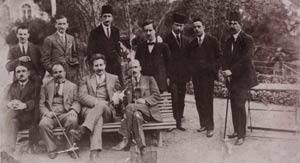 Yahya Kemal Beyatlı (1884-1958) came to Büyükada in 1913 upon the recommendation of Tahsin Nahid and stayed in a fine, pleasant room on the top floor of the Savoy Hotel, with a window facing the street . He also stayed at the Splendid Hotel for a short period. The following year, when he returned to Büyükada, he rented a mansion with Yakup Kadri on Azaryan Yokuşu, with a sea view, two bedrooms, a kitchen at the back and a maid’s room.
Yahya Kemal Beyatlı (1884-1958) came to Büyükada in 1913 upon the recommendation of Tahsin Nahid and stayed in a fine, pleasant room on the top floor of the Savoy Hotel, with a window facing the street . He also stayed at the Splendid Hotel for a short period. The following year, when he returned to Büyükada, he rented a mansion with Yakup Kadri on Azaryan Yokuşu, with a sea view, two bedrooms, a kitchen at the back and a maid’s room.
In addition to his duties at Darülfünun (University), Kemal served as a history teacher at the Heybeliada Naval Academy. Nâzım Hikmet and Necip Fazıl Kısakürek were students of Kemal’s during this period.
Nurullah Ataç
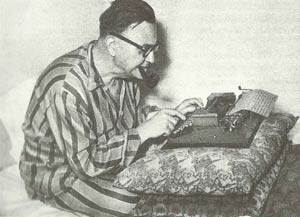 Nurullah Ataç (1898-1957), one of the limited number of authors who only wrote criticisms and essays during the Republic period, was an admirer of the Islands. To him, Büyükada was Istanbul. He rarely went to the city. He complained about not being able to write in Istanbul. Shortly after his daughter Meral was born, Nurullah Ataç settled on Büyükada with his family. Meral Ataç Tolluoğlu sincerely describes her memories of her father and Büyükada in her book, Babam Nurullah Ataç:
Nurullah Ataç (1898-1957), one of the limited number of authors who only wrote criticisms and essays during the Republic period, was an admirer of the Islands. To him, Büyükada was Istanbul. He rarely went to the city. He complained about not being able to write in Istanbul. Shortly after his daughter Meral was born, Nurullah Ataç settled on Büyükada with his family. Meral Ataç Tolluoğlu sincerely describes her memories of her father and Büyükada in her book, Babam Nurullah Ataç:
“In terms of nature, the island is far more beautiful in winter than summer. The inhabitants of the island are like kith and kin. Everybody knows each other, greet each other and ask after each other. To live in such a place gives people both happiness and trust. Also, my uncle and his family live here both in summer and winter. After my father and mother thought about it, they decided to settle on the Island again after they moved.”
From Babam Nurullah Ataç
He resided at: Ataç House Lonca Sokağı No:24
Reşat Nuri Güntekin
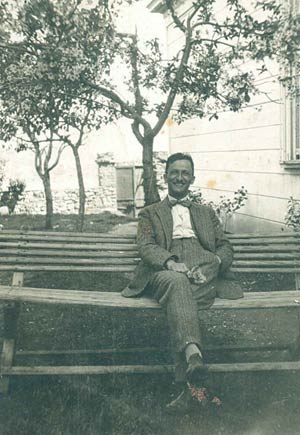 Reşat Nuri Güntekin (1889-1956), the author of Çalıkuşu, one of the most widely read novels in Turkish literature, settled on Büyükada in the 1930’s with his family because he liked living in quiet places. He hosted his relatives more often than his writer friends; he hosted dinner for them, as they played on the swings in the garden. His daughter, Ela Güntekin, who came to Büyükada when she was only a few months old, spent time with her father as they walked and chatted. For many years, the family spent their summers on the island.
Reşat Nuri Güntekin (1889-1956), the author of Çalıkuşu, one of the most widely read novels in Turkish literature, settled on Büyükada in the 1930’s with his family because he liked living in quiet places. He hosted his relatives more often than his writer friends; he hosted dinner for them, as they played on the swings in the garden. His daughter, Ela Güntekin, who came to Büyükada when she was only a few months old, spent time with her father as they walked and chatted. For many years, the family spent their summers on the island.
His novel, Akşam Güneşi, expresses his feelings about Büyükada.
Büyükada, House of Reşat Nuri Güntekin, Museum of the Princes’ Islands Archive
Hüseyin Rahmi Gürpınar
 Hüseyin Rahmi Gürpınar (1864-1944) lived in a rental house for 10 years in the 1900’s. He bought land from Hıdiv Abbas Paşa and built the Gürpınar Mansion, where he lived until his death. The three-storied mansion on Heybeliada looks towards Burgazada, and from the sea, three sides of the house can be seen, far from town, high up a steep slope in a forested area. He is buried here.
Hüseyin Rahmi Gürpınar (1864-1944) lived in a rental house for 10 years in the 1900’s. He bought land from Hıdiv Abbas Paşa and built the Gürpınar Mansion, where he lived until his death. The three-storied mansion on Heybeliada looks towards Burgazada, and from the sea, three sides of the house can be seen, far from town, high up a steep slope in a forested area. He is buried here.
Hüseyin Rahmi describes his life on Heybeliada in Kokotlar Mektebi and mentions the island in Sevda Peşinde and Tebessüm-i Elem
He resided at: Gürpınar Mansion, Demirtaş Sokağı No: 19
Aziz Nesin
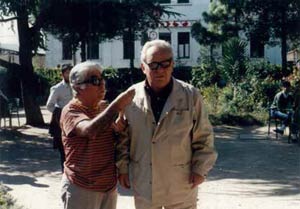 Aziz Nesin (1915-1995) is one of the writers born on the Islands. Nesin lived on Heybeli until he was 10 years old and wrote about the Heybeli of his childhood and the residents in a lively and detailed manner in Böyle Gelmiş Böyle Gitmez.
Aziz Nesin (1915-1995) is one of the writers born on the Islands. Nesin lived on Heybeli until he was 10 years old and wrote about the Heybeli of his childhood and the residents in a lively and detailed manner in Böyle Gelmiş Böyle Gitmez.
“There was only one mosque in Heybeliada: (...) The muezzin of the islands mosque Feyyaz had a serious speech defect, he stammered. He used to talk with great difficulty. But the voice of this stutterer was really beautiful. And he never stammered when he was reciting the call for prayers or chanting the Prophet Mohammed’s nativity hymn. (...) Briefly, we had to discover means to live cheap and find ways to live on a very small amount of money. There were cisterns in most of the houses, because there were no water resources on the island. We did not have a reservoir in our small house. And we could not get water from the peddling watermen who stacked water on to back of their donkeys. Because we did not want to spend money. Me and my sister – but mostly my sister – used to carry water from the fountain at the port side area in a copper churn.”
From Istanbul Boy: The Autobiography of Aziz Nesin.
Zeyyat Selimoğlu
 When mentioning Heybeliada, Zeyyat Selimoğlu (1922-2000) is one of the names that immediately come to mind. Selimoğlu translated many books into Turkish, mostly dealing with ships and the different lives of people who live/work on ships. The book Direğin Tepesinde Bir Adam attracted much attention when it was first published. All of his stories about the sea are collected in the book Gemi Adamları.
When mentioning Heybeliada, Zeyyat Selimoğlu (1922-2000) is one of the names that immediately come to mind. Selimoğlu translated many books into Turkish, mostly dealing with ships and the different lives of people who live/work on ships. The book Direğin Tepesinde Bir Adam attracted much attention when it was first published. All of his stories about the sea are collected in the book Gemi Adamları.
Ahmet Rasim
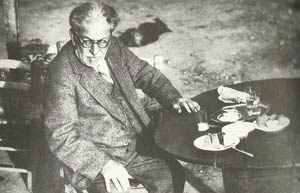 Ahmet Rasim (1865-1932) settled on Heybeliada after living in Kadıköy and he spent the last days of his life here. He wrote about the islands in his quick and extremely entertaining style.
Ahmet Rasim (1865-1932) settled on Heybeliada after living in Kadıköy and he spent the last days of his life here. He wrote about the islands in his quick and extremely entertaining style.
Kitabe-i Gam is Rasim’s letter novel written for a beautiful woman whom he knew and loved on the Island.
He resided at: Ahmet Rasim House, Heybeliada, Hüseyin Rahmi Sokağı No: 25/1
Sait Faik Abasıyanık
 Sait Faik Abasıyanık (1906-1954) wrote about the Islands, the fishermen and the fish and is identified with Burgazada. He spent most of the last ten years of his life in the mansion at 15 Çayır Sokak.?The mansion was converted into a museum upon the will of his mother, Makbule Abasıyanık, and the Sait Faik Abasıyanık Museum was opened by the “Burgazadası’nı Güzelleştirme Derneği (The Beautification of Burgazadası Association)” on 22 August 1959. The maintenance and restoration responsibilities of the museum are met by the Darüşşafaka Cemiyeti (Darüşşafaka Association).
Sait Faik Abasıyanık (1906-1954) wrote about the Islands, the fishermen and the fish and is identified with Burgazada. He spent most of the last ten years of his life in the mansion at 15 Çayır Sokak.?The mansion was converted into a museum upon the will of his mother, Makbule Abasıyanık, and the Sait Faik Abasıyanık Museum was opened by the “Burgazadası’nı Güzelleştirme Derneği (The Beautification of Burgazadası Association)” on 22 August 1959. The maintenance and restoration responsibilities of the museum are met by the Darüşşafaka Cemiyeti (Darüşşafaka Association).
Sait Faik and Burgazada are inseparable. One will always be associated with the other and one is incomplete without the other.
He resided at: Sait Faik House, Çayır Sokağı No: 15
Halide Edip Adıvar
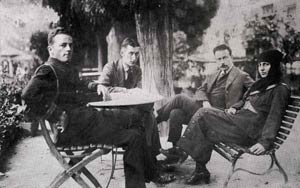 Halide Edip Adıvar (1884-1964), one of the most important writers in Turkish literature, is among those who settled on Burgazada to escape the noise of Istanbul. Her home, Zafiriadis House, with a rose garden and covered by wisteria, held a special place in her heart.
Halide Edip Adıvar (1884-1964), one of the most important writers in Turkish literature, is among those who settled on Burgazada to escape the noise of Istanbul. Her home, Zafiriadis House, with a rose garden and covered by wisteria, held a special place in her heart.
Some parts her novel, Raik’in Annesi, are set on Burgaz. She resided at: Zafiriadis House, Mehtap Sokağı No: 43
Fazıl Ahmet Aykaç
 Fazıl Ahmet Aykaç (1884-1967), whose humor and witty conversations are often quoted, is a symbol of Kınalıada. He brought important innovations to the fields of humour and poetry. He imitated many of the famous poets and poems of the period, which made him a much talked about figure.
Fazıl Ahmet Aykaç (1884-1967), whose humor and witty conversations are often quoted, is a symbol of Kınalıada. He brought important innovations to the fields of humour and poetry. He imitated many of the famous poets and poems of the period, which made him a much talked about figure.
He hosted many of his friends at his house on Kınalıada. İhap Hulusi memorialized their friendship and their conversations in the raki label he drew for Kulüp Rakısı. Naşide Görey, İhap Hulusi’s wife, tells the story of the creation of the label:
“For that Tekel raki, he developed compositions in his mind, drew sketches, tried a few models, but he was not satisfied. Meanwhile, his close friend Fazıl Ahmet Aykaç was watching him. İlhap Bey turned and said; “Fazıl, come and sit here!’ and he came and sat before him. Thus, that famous label of Kulüp Rakısı was created and has been used since that day for over half a century.”
He resided at:?. Civanyan House, Çandarlı Sokağı No: 9?. Ağasi House, Fazıl Ahmet Aykaç Caddesi No: 23
Zabel Asadur
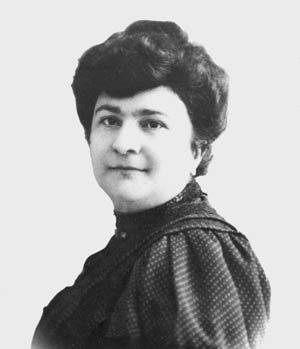 Lawyer and writer Hrand Asadur (1862-1928) and his well-known writer and poet wife, Zabel Asadur (1863-1924, nee Hancıyan), lived in a four-storied wooden house on Kınalıada known as the Derunyan house.
Lawyer and writer Hrand Asadur (1862-1928) and his well-known writer and poet wife, Zabel Asadur (1863-1924, nee Hancıyan), lived in a four-storied wooden house on Kınalıada known as the Derunyan house.
Zabel Asadur, whose goal when she was sixteen was to open schools and orphanages for the education and training of Armenian girls in Anatolia, established “Azkanıver Hayuhyats Ingerutyun” (Nationalist Armenian Women’s Association) and wrote about the problems of women in her articles published?in Masis magazine under the penname “Sibil”. She devoted herself to the liberalization of women. Asadur, who wrote for periodicals in Armenian and translated from French, also served at the Esayan and Getronogan schools as an Armenian teacher.
Zahrad
 Zahrad, whose real name was Zareh Yaldızcıyan (1924-February 21, 2007), lived on Kınalıada for many years. His first book of poetry, Büyük Şehir, was published in 1960 and translated into twenty-five languages. The poetry of this globally known poet were translated into Turkish by caricaturist, Ohannes Şaşkal and published in three anthologies: Yağ Damlası, Yapracığı Gören Balık, Işığını Söndürme.
Zahrad, whose real name was Zareh Yaldızcıyan (1924-February 21, 2007), lived on Kınalıada for many years. His first book of poetry, Büyük Şehir, was published in 1960 and translated into twenty-five languages. The poetry of this globally known poet were translated into Turkish by caricaturist, Ohannes Şaşkal and published in three anthologies: Yağ Damlası, Yapracığı Gören Balık, Işığını Söndürme.
For Zahrad, who put forward the feeling of space in his poems, Istanbul was always the island.
Yakup Kadri Karaosmanoğlu
“We were endowed with the opportunity to spend the most beautiful, most enthusiastic and the merriest of those days in Büyükada owing to the hospitality of our friends Tahsin Nahit and his wife. I said ‘Tahsin Nahit and his wife’s hospitality’. Because their house at Maden became a meeting place for us and a center of attraction. Tahsin Nahit was above all known as the poet of the Islands, island pines and island fullmoons. His wife, on the other hand was born and raised in Büyükada and I can freely say that it was this couple who taught us the beauty of the island, and also who made us love it.”
Yakup Kadri Karaosmanoğlu,
Memoirs of Youth and Literature
History of the Islands
- Details
- Created on 17 February 2013
- Last Updated on 05 April 2013
Formation of the Islands




From the First Settlement Until Today
 In antiquity the archipelago was called Demonisia, the People’s Isles. During Byzantine times the archipelago came to be known as Papadonisia, the Islands of the Monks, from the many monasteries that had been established on the various isles. These monasteries became famous for the emperors, empresses, and patriarchs who were exiled there, some of them never to return to Constantinople. According to the Byzantine chronicler Kedrenos, the emperor Justin II (r. 565-78) built himself a palace and monastery on the largest of the islands in 569. This isle had been known as Megale, or the Great, but after the emperor established residence there it came to be called Prinkipo, the Isle of the Prince. Later the entire archipelago came to be called the Prinkiponisos, or the Princes’ Isles.
In antiquity the archipelago was called Demonisia, the People’s Isles. During Byzantine times the archipelago came to be known as Papadonisia, the Islands of the Monks, from the many monasteries that had been established on the various isles. These monasteries became famous for the emperors, empresses, and patriarchs who were exiled there, some of them never to return to Constantinople. According to the Byzantine chronicler Kedrenos, the emperor Justin II (r. 565-78) built himself a palace and monastery on the largest of the islands in 569. This isle had been known as Megale, or the Great, but after the emperor established residence there it came to be called Prinkipo, the Isle of the Prince. Later the entire archipelago came to be called the Prinkiponisos, or the Princes’ Isles.

During the Byzantine era, when Constantinople was protected by its great walls, the Princes’ Isles were left exposed and were ravaged during enemy sieges. This was particularly so in the Arab invasions of the seventh and eighth centuries, in the sack of Constantinople by the Venetians and the knights of the Fourth Crusade in 1204, and in the attacks that led up to the capture of the Byzantine capital in 1453 by the Ottomans under Mehmet II. The islands were secure under Ottoman rule, though in 1807 a squadron of the British Navy under Admiral Sir John Duckworth forced its way through the Dardanelles and the Marmara and anchored off Kınalıada for eleven days, during which time they bombarded the island before sailing back to the Aegean.
During the Byzantine era, Antigoni, Halki and Prinkipo were inhabited almost entirely by the families of Greek fishermen and mariners, while Armenians predominated on Proti. During the late Ottoman era, prosperous Turkish and Jewish families took up residence on the islands as well, particularly on Büyükada, along with a few foreign diplomats and businessmen. There are still significant Armenian and Jewish communities on some of the islands, and also a number of Greeks, but today the vast majority of the islanders are Turkish.
Chronological History of the Princes' Islands

The First Ferries to the Islands
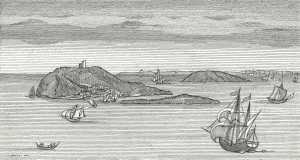 The first ferries to the islands, beginning in the eighteenth century, were the large rowing craft known as "pazar kayık". Small steam-powered ferries made their appearance in 1846, to be followed by larger steamboats when the Şirket-i Hayriye began regularly scheduled ferry service to the islands at the beginning of the second half of the nineteenth century. This led to a great increase in the population of the islands, both in the number of year-round residents and those with summer homes. There was also a huge influx of day-trippers and overnight visitors on weekends and holidays, which led to the erection of hotels on the larger islands, although there are fewer hostels now than there were in times past. The ferry service has been expanded in recent years, with high-speed sea buses going out to the islands from Kabataş on the Bosphorus in addition to the regular ferryboats from the Adalar station on the Golden Horn. Despite these developments, the archipelago is still largely unspoiled, particularly because automotive transport is banned, except for a few municipal vehicles. Otherwise the only means of transport on Burgazada, Heybeliada and Büyükada is by fayton, or horse-drawn carriage, while on Kınalıada one must either walk or ride a bicycle.
The first ferries to the islands, beginning in the eighteenth century, were the large rowing craft known as "pazar kayık". Small steam-powered ferries made their appearance in 1846, to be followed by larger steamboats when the Şirket-i Hayriye began regularly scheduled ferry service to the islands at the beginning of the second half of the nineteenth century. This led to a great increase in the population of the islands, both in the number of year-round residents and those with summer homes. There was also a huge influx of day-trippers and overnight visitors on weekends and holidays, which led to the erection of hotels on the larger islands, although there are fewer hostels now than there were in times past. The ferry service has been expanded in recent years, with high-speed sea buses going out to the islands from Kabataş on the Bosphorus in addition to the regular ferryboats from the Adalar station on the Golden Horn. Despite these developments, the archipelago is still largely unspoiled, particularly because automotive transport is banned, except for a few municipal vehicles. Otherwise the only means of transport on Burgazada, Heybeliada and Büyükada is by fayton, or horse-drawn carriage, while on Kınalıada one must either walk or ride a bicycle.
The Names of the Islands in History
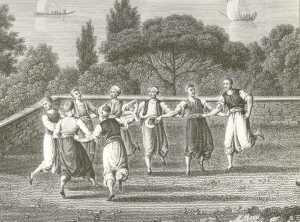 In antiquity the archipelago was called Demonisia, the People’s Isles. During Byzantine times the archipelago came to be known as Papadonisia, the Islands of the Monks, from the many monasteries that had been established on the various isles. The emperor Justin II (r. 565-78) built himself a palace and monastery on the largest of the islands in 569. This isle had been known as Megale, or the Great, but after the emperor established residence there it came to be called Prinkipo, the Isle of the Prince. Later the entire archipelago came to be called the Prinkiponisos, or the Princes’ Isles..
In antiquity the archipelago was called Demonisia, the People’s Isles. During Byzantine times the archipelago came to be known as Papadonisia, the Islands of the Monks, from the many monasteries that had been established on the various isles. The emperor Justin II (r. 565-78) built himself a palace and monastery on the largest of the islands in 569. This isle had been known as Megale, or the Great, but after the emperor established residence there it came to be called Prinkipo, the Isle of the Prince. Later the entire archipelago came to be called the Prinkiponisos, or the Princes’ Isles..
Büyükada - Prinkipo
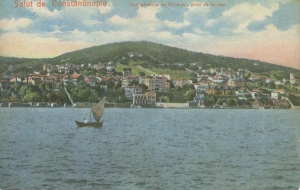 The island is rich in historical associations. The earliest of these concern the palace built in 569 by Justin II (r. 565-78), nephew and successor of Justinian (r. 527-65). According to the chronicler Kedrenos, Justin had a "farm estate" on the island, on which he built his palace and probably also a monastery. The name of the monastery is unknown, although it is believed to be the convent where several empresses of Byzantium and at least one emperor were confined during their periods of exile.
The island is rich in historical associations. The earliest of these concern the palace built in 569 by Justin II (r. 565-78), nephew and successor of Justinian (r. 527-65). According to the chronicler Kedrenos, Justin had a "farm estate" on the island, on which he built his palace and probably also a monastery. The name of the monastery is unknown, although it is believed to be the convent where several empresses of Byzantium and at least one emperor were confined during their periods of exile.
The palace and convent are believed to have been on the northeastern shore of the island in the district now known as Maden, or the "Mine," so called because of the iron mine that was worked there in the mid-nineteenth century. The archaeological evidence to support this includes a capital bearing a monogram with the name of the empress Sophia, wife of Justin II. Another capital with a monogram giving the name of the emperor himself was found in the present church of St. Dimitrios in the village of Büyükada.
Ernest Mamboury, in a paper published in 1943, reported on archaeological finds he made in the Maden district, in an area known as Kamares, or the "Arches," doubtless from the ruins that were then still visible there. Mamboury estimated that the convent occupied an area of about 300 square meters, its north and south wings each about 250 meters long, with the ruins of the conventual church still evident within the enclosure. However, these remains have now utterly disappeared.
The convent was rebuilt and enlarged by the empress Eirene (r. 797-802), one of the few women to rule Byzantium in her own right. Eirene was the wife of Leo IV (r. 775-80) and mother of his son and successor, Constantine VI (r. 780-97). Constantine was only ten when he succeeded to the throne, and so his mother Eirene was made regent and immediately began restoring icons to the churches of Byzantium, from which they had been banned by the iconoclastic policy of her late husband. Constantine took power in 790 and confined his mother to the palace, but he proved incapable of rule and two years later he released Eirene and crowned her as co-emperor. Then in 797 Eirene and her supporters overthrew Constantine, who was blinded by his mother and sent into exile in the convent that the empress had founded on Prinkipo. Constantine died a few days later and was buried in the graveyard of the convent.
Eirene thus became the first woman ever to rule the Byzantine Empire on her own, though her unnatural crime profoundly shocked Constantinople. As the chronicler Theophanes wrote: "And the sun was darkened during seventeen days, and gave not his light, so that ships ran off course, and all men said and confess that because the emperor was blinded, the sun had put away his rays. And in this way power came into the hands of Eirene, his mother."
Eirene ruled on her own for more than five years, but then on 31 October 802 she was deposed in a palace coup, to be succeeded by Nicephorus I (r. 802-11). Eirene was then exiled, first to her convent on Prinkipo and then to the island of Lesbos in the Aegean, where she died the following year. Her remains were brought back and buried in the graveyard of her convent on Prinkipo, laid to rest beside her son Constantine. Their graves were tended by the Princess Euphrosyne, who had been exiled to the convent with her father. Euphrosyne remained in the convent for twenty-seven years; she was finally released in 824 to become the bride of the recently widowed Michael II (r. 820-9), a usuper of plebian origins who married the princess to lend legitimacy to his reign.
The next imperial exile in the convent was the empress Zoe, daughter of Constantine VIII (r. 1025-8) and wife in turn of Romanus III Argyrus (r. 1028-34), Michael IV (r. 1034-41), and Constantine IX Monomachus (r. 1042-55). After the death of Michael IV the succession passed to Michael V (r. 1041-2), the adopted son of Zoe, who turned on his foster mother and exiled her to the convent on Prinkipo. This infuriated the people of Constantinople, who overthrew and exiled Michael, after which they raised Zoe and her younger sister Theodora to the throne. The sisters ruled as co-emperors for three months until they were succeeded by Constantine IX Monomachus (r. 1042-55), who married Zoe on 12 June 1042 and was crowned as emperor the following day.
When Isaac I Comnenus (r. 1057-9) was suffering through his last illness he tried to arrange for his younger brother John to be his successor. But when Isaac abdicated, the landowning military aristocracy passed over John in favor of one of their own, who was crowned as Constantine X Ducas (r. 1059-67). John Comnenus was then sent into exile on Prinkipo, where he was confined to a monastery, while his wife Anna Dalassena and their children took up residence in the convent that had been founded by the empress Eirene. After a few months John was allowed to leave Constantinople with his family and go into obscure retirement in a remote part of the empire, where he died in 1067. Anna bided her time until her eldest son succeeded to the throne as Alexius I Comnenus (r. 1081-1118). Alexius then crowned his mother as empress, and she was the power behind the throne until her death in 1102. When Alexius himself died in 1118 his wife, the empress Eirene Ducaena, retired to the convent on Prinkipo, where she died five years later, the last of the imperial exiles to be be consigned to the island.
Heybeliada - Halki
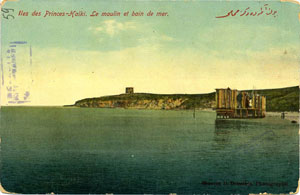
Halki, the Greek name of the island, which means "copper," comes from the copper mines that were worked here in antiquity, mentioned by Aristotle. The island took its Turkish name, Heybeli, from the word for saddlebag, heybe, which it is said to resemble because of the shape of its hills and their intervening valleys.
In Byzantine times, there were at least three monasteries on Heybeliada, then known as Halki. The most renowned of these was Hagia Triada, the Holy Trinity, whose site on Ümit Tepesi is occupied by the Greek Orthodox theological school of the same name, a direct descendant of the original Byzantine monastery. The present monastery is the most prominent monument on Heybeliada, dominating the view from an approaching ferry and from within the village itself.
The earliest reference to a monastery on Halki is in the writings of St. Theodore of Studius early in the ninth century. Theodore, abbot of Constantinople’s famous monastery of St. John of Studius, was exiled to a monastery on Halki by Leo V (r. 813-20) because of his criticism of the emperor’s iconoclastic policy. While on Halki, Theodore wrote a number of letters, theological treatises, and poems, one of which was addressed fondly to the monastic cell in which he was confined. Theodore does not name the monastery, but other evidence would seem to indicate that it was the Holy Trinity. Theodore’s letters say that after Leo V was assassinated in 820, his widow, the empress Theodora, and her daughters were exiled to the monastery on Halki by the new emperor, Michael II. Theodore and the other residents of the Holy Trinity were then evicted to make way for the empress and her daughters. Thus there would seem to have been another monastic establishment on Halki where the displaced monks could find shelter, and it has been suggested that this was the monastery of St. John the Baptist.
Burgazada - Antigoni
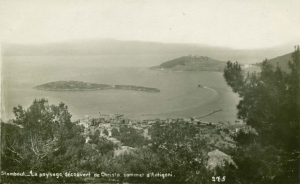 In antiquity the island was known as Panormos, but in Byzantine times it was called Antigoni, the name still used by the Greeks. The Turkish name of Burgaz is a corruption of the Greek pyrgos, or tower, from an ancient watchtower on its summit that is mentioned by Evliya Çelebi and other travelers up until the early nineteenth century. The watchtower can be seen on the summit of the island in an engraving done in 1794 by Cosimo Comidas. The engraving shows the island bare except for what appear to be an orchard and two or three cultivated patches on the side of the hill.
In antiquity the island was known as Panormos, but in Byzantine times it was called Antigoni, the name still used by the Greeks. The Turkish name of Burgaz is a corruption of the Greek pyrgos, or tower, from an ancient watchtower on its summit that is mentioned by Evliya Çelebi and other travelers up until the early nineteenth century. The watchtower can be seen on the summit of the island in an engraving done in 1794 by Cosimo Comidas. The engraving shows the island bare except for what appear to be an orchard and two or three cultivated patches on the side of the hill.
In more recent times, the island was densely wooded, principally with pines. Unfortunately, a fire in 2003 destroyed most of the trees above the village, but the area has been replanted with pine saplings.
The single hill, Hristos Tepesi (Christ Hill), also known as Bayraktepe (Flag Hill), rises to a height of 170 meters in the middle of the island. The center of the village is on the northeast coast of the island, its houses stretching from there along the heights above the northern shore. The shore roads extend around all of the island except its inhospitable south coast, where precipitous cliffs hang over the sea.
During Byzantine times there were at least two monasteries on the island, one of them dedicated to St. John the Baptist (Hagios Ioannis Prodromos), and the other to the Transfiguration of Christ, but neither seems to have housed any royal exiles.
The earliest reference to the monastery of St. John is in the diary of the Reverend John Covel, who in his entry for 2 May 1675 writes: "There hath been a monastery upon Antigono, but now it is decaid, and shrunk to a little church dedicated to St. John." Covel visited the island again on 2 April 1677, when he made the following entry in his diary: "That evening about 5 a clock, we set sail from Pera, and came to Antigono, where we lay in a poor tavern. The town is not worth any notice. The wine is ordinary...the water very bad; bread dear and not very good."
The only famous personage exiled on Antigoni during the Byzantine period was St. Methodios the Confessor, Patriarch of Constantinople (r. 842-6), who was imprisoned in the monastery of St. John by Michael II, the Stammerer, during the years 822-9 because of his opposition to the emperor’s policy of iconoclasm. After Michael’s death in 829 his son and successor, the emperor Theophilos (r. 829-42), released Methodios and allowed him to return to Constantinople. Methodios was elected patriarch in 842 and the following year he convened a Church Council that restored the veneration of icons, ending the Iconoclastic Period. After Methodios died in 846 he was canonized, his body having been laid to rest in the church of the Holy Apostles among the tombs of the Byzantine emperors.
Kınalıada - Proti
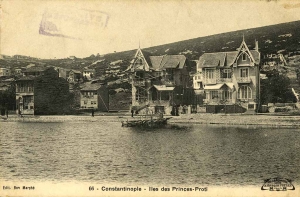 The Greeks have always called the island Proti, or First, since it is the nearest of the islands to the city. It is the smallest of the four major islands, with an area of 1.356 square kilometers.
The Greeks have always called the island Proti, or First, since it is the nearest of the islands to the city. It is the smallest of the four major islands, with an area of 1.356 square kilometers.
The Reverend John Covel, chaplain of the Levant Company in Galata, made two voyages out to the islands in 1676-7, and on the second of these he observed that the village on Proti had been destroyed and abandoned, though there is no record of what catastrophe might have been responsible for this. As Covel writes in his entry for 26 February 1677:
We left Chalcis [Halki]. We past by Antigono [Antigoni], and came to Prote [Proti]. There is no village there, but onely a monastery on the top dedicated to our Saviour, Haghios Sotir. They have all the island to themselves. There is no vineyards, it being most rocky barren ground. It is decimated, and hath a stavromenos [a monastery belonging to one on Mount Athos]. There are about ten or fifteen kaloyeri [monks]. They had a fine herd of goats, and then above thirty young kids in their mandra [enclosure for cattle]. There are good olives, flax, and some corn ground. There is on the east side going up a pond, but the water is not good or lasting all the year, proceeding onely from the rain or snow, and not regarded or preserved as a cistern. On that side there hath been a town, but all is now level’d with the ground. On these islands there are wells or cisternes, and as good water as can be drunk.
The monastery described by Covel is one of several known to have been founded on Proti in Byzantine times. The one that he describes was dedicated to the Transfiguration of the Saviour (Metamorphoseos tou Sotiros) and housed several distinguished exiles, including a number of emperors and empresses of Byzantium.
The first of these exiles was the Armenian general Bardanes, who in 803 revolted against the emperor Nicephorus I (r. 802-11). The army proclaimed Bardanes emperor and he advanced upon Constantinople, but as his troops approached the capital they began deserting to Nicephorus. Bardanes was persuaded to surrender to Nicephorus, who had him blinded and exiled to Proti, where he spent the rest of his days as a monk, perhaps in a monastery that he founded himself.
The emperor Michael I Rhangabe (r. 811-13) was deposed by his Armenian general Leo, who succeeded to the throne as Leo V (r. 813-20). Leo sent Michael off into exile to the monastery of the Transfiguration on Proti. Michael was accompanied in his exile by his wife, the empress Procopia, and their four children, two daughters and two sons. Procopia and her daughters took the habit as nuns, while Michael and his two sons, Theophylact and Nicetas, became monks, the two boys being castrated so that they could never succeed their father as emperor. Michael died on Proti in 840 and was buried in the monastery graveyard. Nicetas, who took the name Ignatius when he became a monk, eventually was allowed to leave Proti and served two terms as patriarch of Constantinople (847-58, 867-77); after his death he was canonized as a saint in the Orthodox Church.
Leo was assassinated in 820 by Michael the Amorian, who succeeded to the throne as Michael II. Michael then exiled Leo’s widow, Theodosia, and her four children to the monastery of the Panagia, or Holy Virgin, on Proti, where the remains of the deposed emperor were buried.
Romanus I Lecapenus (r. 919-44), an Armenian, was overthrown on 17 December 944 by his sons Stephen and Constantine, who then had themselves crowned as co-emperors and sent their father into exile in the monastery of the Transfiguration on Proti. But then on 27 December Stephen and Constantine were themselves deposed and sent off into exile at the same monastery. Romanus died there on 15 June 948, while Stephen and Constantine were subsequently sent off into more distant exile on an island in the Aegean, where they were confined in a monastery for the rest of their days.
Romanus II (r. 959-63) scandalized Byzantium by marrying a beautiful courtesan named Theophano. When Romanus died in an accident in 963 Theophano married his successor, Nicephorus II Phocas (r. 963-9), an Armenian general. Six years later Theophano and her lover John Tzimisces, another Armenian general, conspired to assassinate Nicephorus, whom they killed on 10 December 969. The following day Tzimisces was crowned as the emperor John I (r. 969-76). Theophano thought that he would marry her and that she would become an empress for the third time, but Tzimisces exiled her to a monastery on Proti, where she remained for the rest of her life.
Romanus IV Diogenes (r. 1067-71) was deposed in 1071 after his catastrophic defeat by the Seljuk Turks at the battle of Manzikert. His successor, Michael VII Doucas (r. 1071-8), blinded Romanus and exiled him to the monastery of the Transfiguration on Proti, where he died on 4 August 1072.
Kınalıada has three peaks, with Çınar Tepesi (Plane Tree Hill) rising in the northeast of the island to an elevation of 115 meters, Teşrifiye Tepesi (110 m.) in the center, and Manastır Tepesi (93 m.) in the south. All three hills are almost treeless but are covered with brush, just as they appear in an engraving of the island done in 1794 by Cosimo Comidas. The engraving shows two of the hills crowned with large structures which are undoubtedly monasteries, one of them overshadowed by an enormous cypress. Teşrifiye Tepesi is now studded with a dozen television and communications antennae, an unsightly reminder that the modern world has penetrated these once idyllic isles.
Kınalıada is the most barren of the four major islands, as Grosvenor notes in his description of its appearance, where he interprets its topography in terms of two hills rather than three and gives it three monasteries:
Proti, the First or Nearest, consists of two prolonged and lofty mounds. A belt of trees spans the hollow. No water-springs refresh its bare and arid surface. Stunted shrubbery and a few straggling houses cling like moss along the slopes. Its very appearance is suggestive of the sorrows and tragedies it has seen, all accomplished within the walls of three monasteries between which the island was shared.
Sedefadası - Antirovithos
The name of the island is said to derive either from sedef (mother-of-pearl) or from sedefotu, the rue plant commonly found here.
St. Ignatius founded a monastery for men on Antirovithos in the mid-ninth century, one of three monastic establishments he built on the Princes’ Isles, all of which are mentioned in the list made by Manuel I Comnenus in 1158. The monastery on Antirovithos was restored in 1180 by the patriarch Theodosius Boradiotis. All that remains of the monastery today is a fragmentary ruin on the northwestern promontory of the island.
During the reign of Mahmut II (r.1808-39) the island was given over to the sultan’s son-in-law, Rodosizade Damat Fethi Ahmet Paşa, who planted two thousand olive trees and five thousand artichoke plants.
The Smaller Islands
Sivriada - Oxia
Despite its small size, Oxia (Sivriada) had its monastery, of which some remnants have survived. This establishment is mentioned in the list of monasteries compiled in 1158 by the emperor Manuel I Comnenus. The monastery had two churches: a katholikon of the Archangel Michael and a chapel dedicated to a number of martyred saints. Several abbots of the monastery subsequently became patriarch of Constantinople. Substantial ruins of the monastery can still be seen on the hillside beside the quay on the inner side of the port.
The earliest mention of the island in Ottoman times is by Petrus Gyllius, who stopped there in 1545. The island’s chief fame in modern times is that on several occasions all the wild dogs of Istanbul were rounded up and exiled there, where they soon ate each other up.
Yassıada - Plati
Yassıada measures 300 by 190 meters, with a maximum elevation of forty meters. It too had its monastery, founded in the mid-ninth century by St. Ignatius, who was twice patriarch of Constantinople (847-58, 867-77). The monastery, mentioned by Manuel I Comnenus in his listing of 1158, had a katholikon dedicated to the Forty Martyrs and also a chapel of the Virgin. Ernest Mamboury, writing in his 1943 guide to the Princes’ Isles, reports that he found remnants of one of these churches, whose ruins now seem to have vanished.
Sir Henry Bulwer, British ambassador to the Sublime Porte, purchased Yassıada in 1857 with the intention of developing it as a market garden. At the time his mistress was Eurydice Aristarchi, Princess of Samos, for whom he erected what Mamboury calls a chateau moyennageux (medieval chateau), where Bulwer and his entourage were popularly believed to have indulged in "nameless orgies.
Kaşıkadası - Pita
Kaşıkadası is the smallest of the nine islands of the archipelago and its highest point a mere eighteen meters above sea level. It has no known history, and it was the only isle in the archipelago that did not have a monastery in Byzantine times.
Tavşanadası - Neandros
Small though it is, Neandros was the site of a monastery, founded in the mid-eighth century by St. Ignatius, son of the emperor Michael I and twice patriarch of Constantinople, who spent his last years in his monastery on Neandros, where he died and was buried in 877. The monastery is mentioned in the list made in 1158 by Manuel I Comnenus. The empress Theodora, wife of the emperor Theophilus (r. 829-42), was confined to the monastery on Neandros in 856 by her son Michael III (r. 842-67), the Sot, for whom she had served as regent until he came of age. Michael VII Doucas (r. 1071-8) was confined to the monastery after he was deposed and blinded in 1078, and he remained there until his death in 1090. The fragmentary ruins of the monastery can still be seen on the island, which is totally uninhabited.
Vordonosadası - Vordonosi
Tiny though it is, it too was the site of a Byzantine monastery, founded in the second half of the ninth century by the patriarch Photius.
From the Voyagers' Journals
- Details
- Created on 17 February 2013
- Last Updated on 01 April 2013
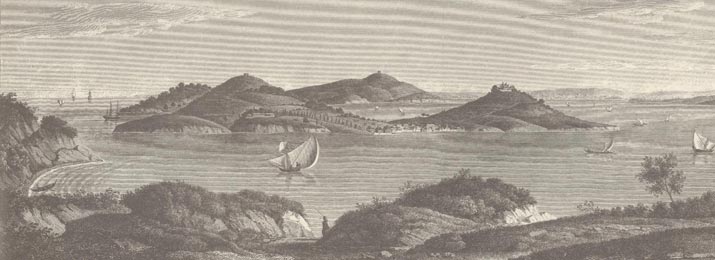
The Turkish chronicler Evliya Çelebi, author of the Seyahatname, or Chronicle of Travels, writes of two voyages that he and his companions made to the islands in 1640 (AH 1050), the first of which took them from the Bosphorus to Heybeli on their way to Bursa:
We weighed anchor at Emirgan on the Bosphorus, and called at F›nd›kl› to take on board as passengers some clever ship-builders; and in the morning on the first Friday of Moharrem of the year 1050, the boatmen finding the time favorable for sailing, unfurled the sails and weathered Seraglio Point; laying the ship’s head toward Bursa, the object of our voyage. All the passengers were in high spirits, and some of them implored the Lord’s assistance for a happy voyage by singing spiritual songs. Some musicians encourged me to accompany them in their strains, and so...I fixed on the measure girdanieh, and sang three tetrasticks and one sumayi of the compositions of Dervish Omerbestieh. Some of the boatmen accompanied us on their instruments, chokur, with such effect, that water came into the mouths of the hearers with delight. Amidst these amusements we came to the isle of Heybeli, eighteen miles from Constantinople and nine in circumference. It contains a famous convent which is visited every year by many boats from Constantinople. The inhabitants are all wealthy Greeks, captains and masters of ships....
Evliya’s estimate of the circumference of Heybeliada is far too large, an exaggeration he also makes in giving the sizes of the other isles in describing another voyage he made later that same year:
 “We embarked for the island of Heybeli... which we have already mentioned. Six miles farther on is the island of Tavshanli [Rabbit or Hare Istand], which derives its name from the infinite number of hares found there; it is only one mile in circumference, and is uncultivated. After rowing eight miles we came to the island of Burgaz with a small but strong castle, situated on the chalk cliff by the seashore. The island is eleven miles in circumference, and... it has three hundred houses with fine gardens and good wells.... The inhabitants are all Greeks, and are rich masters of boats. The island abounds in goats and hares. Kınalı is eight miles in circumference, has a convent and a village of one hundred Greek houses. Ten miles distant from it is Büyükada, a cultivated island twenty miles in circumference, with a village of two hundred Greek houses. On its four sides there are dalyans, lookouts for catching fish.
“We embarked for the island of Heybeli... which we have already mentioned. Six miles farther on is the island of Tavshanli [Rabbit or Hare Istand], which derives its name from the infinite number of hares found there; it is only one mile in circumference, and is uncultivated. After rowing eight miles we came to the island of Burgaz with a small but strong castle, situated on the chalk cliff by the seashore. The island is eleven miles in circumference, and... it has three hundred houses with fine gardens and good wells.... The inhabitants are all Greeks, and are rich masters of boats. The island abounds in goats and hares. Kınalı is eight miles in circumference, has a convent and a village of one hundred Greek houses. Ten miles distant from it is Büyükada, a cultivated island twenty miles in circumference, with a village of two hundred Greek houses. On its four sides there are dalyans, lookouts for catching fish.
The beauty of the Princes’ Isles and the rather grim historical associations of its royal exiles appealed to the romantic imagination of the nineteenth century. This aspect of the islands is evoked in a purple passage at the beginning of Gustave Schlumberger’s charming book Les Iles des Princes, first published in 1884:
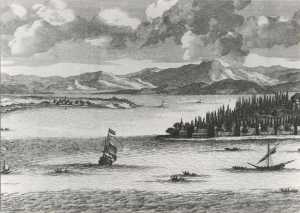 "Naples has its Capri and its Ischia: Constantinople its Princes’ Isles. The Neapolitan is not more proud of the jewels that adorn his bay than is the Greek of Pera of his charming islands, places of repose and pleasure, that raise their enchanting silhouettes at the entrance to the Sea of Marmara. Just as the crimes of Tiberius almost as much as the splendors of nature have made Capri famous, so the gloomy adventures of emperors, empresses and all the exiles of high rank, relegated to the convents of Proti, Antigoni, and Prinkipo as well as a result of the revolutions with which the history of Byzantium bristles, have made these radiant islands one of the most tragic sites of the ancient world. No corner of the earth is more fertile in stories of lamentable catastrophes, in poignant lessons in the vanity of human grandeur. From this point of view alone the Princes’ Isles would deserve a visit from the historian and the thinker. Few places here below have witnessed the groans of more princes and princesses hurled from the splendors of the Imperial Palace to the depths of a cell in some imperial monastery. Add to these moving souvenirs the fact that this archipelago in miniature possesses beauties designed to ravish an eye sated with the marvels of Italy and Sicily, that nowhere does the delighted eye repose on coasts more lovely, on a bay more gracious, on mountainous distances more grandiose; that nowhere is the verdure fresher or more varied; that nowhere in short do bluer waters bathe more gently a thousand shady coves, a thousand poetic cliffs; you will then understand why the Princes’ Isles, bedewed of yore with so many tears, vaunted today with so much praise, are a favorite place of pilgrimage for all those who are attracted by the study of a dramatic past or the charm of a smiling present.
"Naples has its Capri and its Ischia: Constantinople its Princes’ Isles. The Neapolitan is not more proud of the jewels that adorn his bay than is the Greek of Pera of his charming islands, places of repose and pleasure, that raise their enchanting silhouettes at the entrance to the Sea of Marmara. Just as the crimes of Tiberius almost as much as the splendors of nature have made Capri famous, so the gloomy adventures of emperors, empresses and all the exiles of high rank, relegated to the convents of Proti, Antigoni, and Prinkipo as well as a result of the revolutions with which the history of Byzantium bristles, have made these radiant islands one of the most tragic sites of the ancient world. No corner of the earth is more fertile in stories of lamentable catastrophes, in poignant lessons in the vanity of human grandeur. From this point of view alone the Princes’ Isles would deserve a visit from the historian and the thinker. Few places here below have witnessed the groans of more princes and princesses hurled from the splendors of the Imperial Palace to the depths of a cell in some imperial monastery. Add to these moving souvenirs the fact that this archipelago in miniature possesses beauties designed to ravish an eye sated with the marvels of Italy and Sicily, that nowhere does the delighted eye repose on coasts more lovely, on a bay more gracious, on mountainous distances more grandiose; that nowhere is the verdure fresher or more varied; that nowhere in short do bluer waters bathe more gently a thousand shady coves, a thousand poetic cliffs; you will then understand why the Princes’ Isles, bedewed of yore with so many tears, vaunted today with so much praise, are a favorite place of pilgrimage for all those who are attracted by the study of a dramatic past or the charm of a smiling present.
Edwin Grosvenor gives an equally impassioned description of the islands and their lugubrious history in his Constantinople, published in 1895:
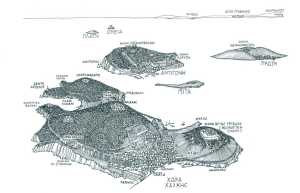 Nature, insatiable in giving, has diversified the capital not only with the Bosphorus and the Golden Horn, but with the tiny archipelago of the Princes’ Isles. More than Ischia and Capri are to Naples, are Khalki, Prinkipo and their sister islands to Constantinople. They are far less remote from the municipal centre, and form an integral part of the city. The nearest is but four miles distant from Kadikeui, and only little farther from Stamboul.
Nature, insatiable in giving, has diversified the capital not only with the Bosphorus and the Golden Horn, but with the tiny archipelago of the Princes’ Isles. More than Ischia and Capri are to Naples, are Khalki, Prinkipo and their sister islands to Constantinople. They are far less remote from the municipal centre, and form an integral part of the city. The nearest is but four miles distant from Kadikeui, and only little farther from Stamboul.
They were anciently called Demonesoi, from a legendary or historic Demonesos, who worked in their stone and metal. Their mediaeval name, Papadanesoi, the islands of the Priests, and the modern name, Princes’ Isles, through the irony of history, have a common meaning and association. During the Byzantine Middle Ages, the monastery was not far distant from the throne. He who, in the evening, wore the imperial golden circlet upon his long and plaited locks might on the morrow, with shaven head, become the unwilling inmate of a monastic cell. In those days, the islands were seldom sought for pleasure, but were abandoned to monasteries and monks. Hither many a deposed sovereign was exiled, whom, stripped of all that made life desirable, the disdain or humanity of his successor permitted to live. Not one of all the discarded emperors imprisoned here, with cowl and cloak, ever went back to his throne. Though almost all the monasteries have crumbled, and only a few inmates wander over the grass-grown paths, the tradition of deposed princes has survived and bestowed upon the islands their present name.
 They are nine in number. Two, Pita and Neandros, are destitute of inhabitant or interest. Three, Oxeia, Pita and Antirovithos, are isolated from the present, but have each their history of failure and sorrow. Four, Proti, Antigone, Khalki, and Prinkipo, are the chief. They are in daily steam communication with one another and with the other quarters of the capital. The mildness and regularity of their climate render them the healthiest locality in the Empire. Nowhere else along the northern Marmora does the olive tree grow with such profusion, or yield more generous results. Nothing more ideal can be pictured than the loveliness of these islands in May and June. The hills are covered with pine forests, and the meandering shores are indented with shaded and sequestered bays. Wherever the gaze is turned, beauty confronts the eye. Yet in winter they are almost deserted. The treacherous Marmora suddenly and often cuts off all communication with the outer world. Then, though at sunset the shadow of Stamboul seems to fall upon them, they are practically many leagues away.
They are nine in number. Two, Pita and Neandros, are destitute of inhabitant or interest. Three, Oxeia, Pita and Antirovithos, are isolated from the present, but have each their history of failure and sorrow. Four, Proti, Antigone, Khalki, and Prinkipo, are the chief. They are in daily steam communication with one another and with the other quarters of the capital. The mildness and regularity of their climate render them the healthiest locality in the Empire. Nowhere else along the northern Marmora does the olive tree grow with such profusion, or yield more generous results. Nothing more ideal can be pictured than the loveliness of these islands in May and June. The hills are covered with pine forests, and the meandering shores are indented with shaded and sequestered bays. Wherever the gaze is turned, beauty confronts the eye. Yet in winter they are almost deserted. The treacherous Marmora suddenly and often cuts off all communication with the outer world. Then, though at sunset the shadow of Stamboul seems to fall upon them, they are practically many leagues away.
Scattered in the sea southeast of the Bosphorus, their rounded forms present a vision of delight. Looked upon from the west, the four chief islands lie spread upon the horizon as if blent in one. Still nearer on the right, Oxeia the Lofty lifts its towering, cone-like rock; while Plati the Flat emerges little above the surface of the water.
The Princes’ Isles are still as beautiful and romantic as Schlumberger and Grosvenor describe them, floating in the mirroring water off the Asian coast of the Marmara between the pale blues of sea and sky, places of refuge and exile from the turbulent megalopolis on the Bosphorus.


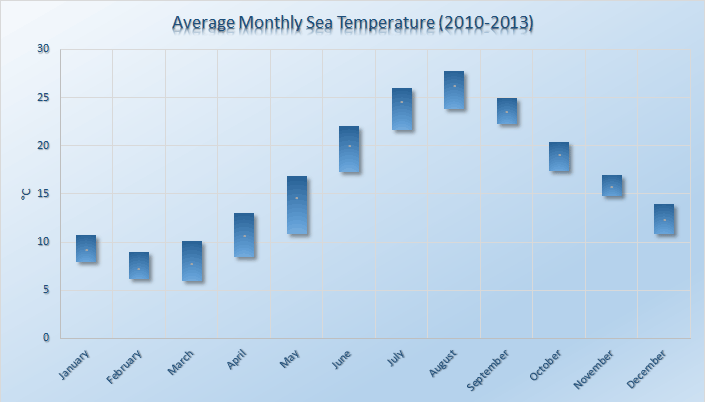
 What To Do
What To Do 